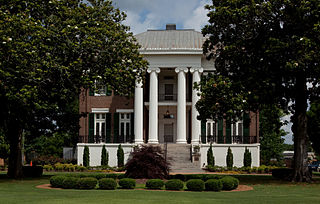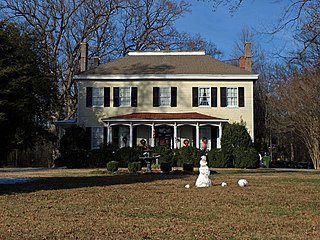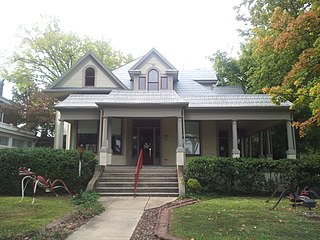
The Rosenbaum House is a single-family house designed by architect Frank Lloyd Wright and built for Stanley and Mildred Rosenbaum in Florence, Alabama. A noted example of his Usonian house concept, it is the only Wright building in Alabama, and is one of only 26 pre-World War II Usonian houses. Wright scholar John Sergeant called it "the purest example of the Usonian."

Mars Hill Bible School is a private, college preparatory Christian day school for boys and girls located in Florence, Alabama. The school begins at pre-kindergarten and continues through the twelfth grade. The school also operates a pre-school on four campuses in the area and has an enrollment of over 300.

Rogers Hall, also known as Courtview, is a three-story antebellum house at 500 Court Street in Florence, Alabama. It was built by enslaved people from 1854 to 1855. It is one of the oldest historic landmarks on the University of North Alabama campus and one of the university's most distinctive structures. The building was recorded by the Historic American Buildings Survey from 1934–35. It was listed on the National Register of Historic Places on June 13, 1974.

The Long Creek Academy is a former Christian school that is located at the intersection of Academy Road and South Carolina S-37-339 near U.S. Route 76 near Long Creek, South Carolina in Oconee County. It was named to the National Register of Historic Places on November 20, 1987. It is currently used by a whitewater rafting company.

The Theophilus Crawford House is a historic house at 53 Hickory Ridge Road South in Putney, Vermont. Built about 1808, it is one of the oldest brick houses in Putney, and one of its finest examples of Federal architecture in brick. It was listed on the National Register of Historic Places in 1995. Its current owners operate it as the Hickory Ridge House Bed and Breakfast Inn.

Oak Place is a historic residence in Huntsville, Alabama. It was built by renowned Huntsville architect George Steele in 1840 on 320 acres. Steele designed a number of buildings across the South, including the First National Bank building in Huntsville, and the second Madison County Courthouse, which stood from 1840 until 1914. Similar to many of his buildings, Steele designed Oak Place house in a Greek Revival style, although much more restrained in detail.

Quietdale is a historic residence in Huntsville, Alabama, US. The house was built in 1854 for Caroline Moore Robinson, the widow of Madison County Sheriff William Robinson. It represents a shift in architecture from Neoclassical to the more eclectic forms that became prominent in the late 19th century.
The Blackburn House is a historic residence near Athens, Alabama. The house was built around 1873. It is a one-and-a-half-story Saltbox-style house with an Italianate portico. The portico has four chamfered edge columns supporting a hipped roof. The portico is flanked by two-over-two sash windows on each floor; the same windows are used on the sides on the first floor and for the front rooms on the second floor. Small casement windows are found above the portico and in the attic areas on the rear sides of the house. The house has a center-hall plan with four rooms on the ground floor and two on the upper floor. Since restoration in the early 1980s, the house has served as an antique store. The house was listed on the Alabama Register of Landmarks and Heritage in 1983 and the National Register of Historic Places in 1984.
Coffee High School was a public high school in Florence, Alabama. After the 2003–04 school year, the school merged with Bradshaw High School to form Florence High School.

The Karsner-Carroll House is a historic residence in Florence, Alabama. The lot on which the house sits was purchased in 1818 by James Gadsden; the lot to the west was purchased by his commanding officer in the War of 1812, Andrew Jackson. The house was built sometime before 1830 by B. F. Karsner. In 1902 it was purchased by Dr. George W. Carroll, whose daughter Bertha later lived in the house with her husband Oscar Y. Kennedy.

The James Martin House is a historic residence in Florence, Alabama. Martin was a leading Florence industrialist of the Antebellum era, who owned a cotton spinning mill along Cypress Creek. He had come to Florence from Jefferson County, Kentucky, and established his mill in 1839. A fire destroyed the complex in 1844, but was rebuilt and reopened in 1850. The mill was destroyed during the Civil War, but not rebuilt before Martin's death in 1869. Martin's sons operated the mill until 1873, and owned the house until 1879. It was purchased in 1886 by John Bounds, and remained in his family until 1974.

Southall Drugs is a historic commercial building in Florence, Alabama. It was built in 1900 to house the pharmacy of Charles Morton Southall. The pharmacy operated until 1979, and was renovated in 1982 to have loft apartments on the second floor and retail on the ground floor.

The Wilson Park Houses are a group of three historic homes in Florence, Alabama. Built as upper-class residences between 1890 and 1918, the houses are adjacent to Wilson Park, laid out as a public space upon the city's founding and later renamed for President Woodrow Wilson. Two of the houses came to be owned by Hiram Kennedy Douglass, who upon his death in 1975 willed the houses to an organization willing to maintain them for the public. The houses are now owned by the city and contain the Kennedy-Douglass Center for the Arts. The houses were listed on the National Register of Historic Places in 1979.

The John and Archibald Christian House is a historic residence near Tuscumbia, Alabama. The house was built in the 1830s by brothers John and Archibald Christian, who were among a group of settlers from the Piedmont region of Virginia who came to Tuscumbia in the 1820s and 1830s. The family had left the house by the 1860s, and in the late 19th century, it was the home of Governor Robert B. Lindsay. In the 1900s, the house was the center of a dairy farm, before it and the surrounding 50 acres were acquired by the Tennessee Valley Country Club in 1923. The country club uses the house as a social meeting area and caretaker's quarters.

The Oaks is a historic residence near Tuscumbia in Colbert County, Alabama. Ricks came to North Alabama from Halifax, North Carolina in the early 1820s. He acquired a large plantation which he sold in 1826 and purchased nearby land, which was worked by the forced labour of enslaved people who he had brought with him. A log house had been built on the new property circa 1818, and Ricks built a new, larger house connected to it which was completed in 1832. The house remained in the family until 1966, and is still in use as a private residence.

The Ernest Edward Greene House is a historic residence in Cullman, Alabama. The house was built in 1913 by Ernest Edward Greene, the superintendent of Southern Cotton Oil Company. After Greene's death in 1922, the house was passed on to several more owners, including John George Luyben, Sr., who lived in the house for 34 years.

The Edmund King House is a historic residence on the campus of the University of Montevallo in Montevallo, Alabama. The house was built by Edmund King, a native Virginian who arrived in Alabama in 1817. First building a log cabin, he built the house in 1823. After becoming a successful planter and businessman, he donated land for churches, roads, and schools, including for the Alabama Girls Industrial School. Upon his death in 1863, the house passed to a son-in-law, and was deeded to the Industrial School in 1908. The house has been used as a classroom, an office building, an infirmary, a home economics practice home, and a summer home for male students. Today, the home is used as a guest house for visitors to the University.

The Worcester Village School is a historic school building at 17 Calais Road in Worcester, Vermont. It was built in 1892, and is a good early example of a town-wide partially graded school with restrained Queen Anne features. It served as a school until 1979, and is now owned by the local historical society. It was listed on the National Register of Historic Places in 2005.

Opp Cottage is a historic residence in Montgomery, Alabama. T. J. and Eliza Wilson began construction on the house in 1860, but it was not completed until 1866, after it was sold to Valentine Opp. Opp was an immigrant from Austria who initially settled in Lowndes County, Alabama, and came to Montgomery after the Civil War. Opp operated a successful tailoring business. Opp's son Henry became a lawyer, the county solicitor of Covington County, and mayor of Andalusia. As attorney for the Louisville and Nashville Railroad, he was instrumental in extending the railroad through the present-day town of Opp, which was named in his honor.

The Theophilus Jones House is a historic house at 40 Jones Road in Wallingford, Connecticut. Built about 1740, it is one of the town's oldest surviving buildings, also notable for its restoration in the 1940s by Charles F. Montgomery. It was listed on the National Register of Historic Places in 1992.





















